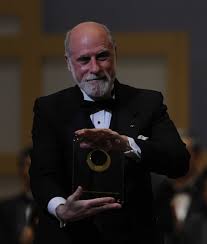I am taking the advice of a reader of this blog and devoting part 2 to examples of old school and modern movies and the visionary science they portray.
Things to Come 1936 — Event Horizon 1997
Things to Come was a disappointment to Wells and Event Horizon was no less a disappointment to audiences. I found them both very interesting as a showcase for some technology and social challenges.… to come- but a little off the mark in regards to the exact technology and explicit social issues. In the final scene of Things to Come, Raymond Massey asks if mankind will choose the stars. What will we choose? I find this moment very powerful- perhaps the example; the most eloguent expression of the whole genre of science fiction. Event Horizon was a complete counterpoint; a horror movie set in space with a starship modeled after a gothic cathedral. Event Horizon had a rescue crew put in stasis for a high G several month journey to Neptune on a fusion powered spaceship. High accelleration and fusion brings H-bombs to mind, and though not portrayed, this propulsion system is in fact a most probable future. Fusion “engines” are old hat in sci-fi despite the near certainty the only places fusion will ever work as advertised are in a bomb or a star. The Event Horizon, haunted and consigned to hell, used a “gravity drive” to achieve star travel by “folding space.” Interestingly, a recent concept for a black hole powered starship is probably the most accurate forecast of the technology that will be used for interstellar travel in the next century. While ripping a hole in the fabric of space time may be strictly science fantasy, for the next thousand years at least, small singularity propulsion using Hawking radiation to achieve a high fraction of the speed of light is mathematically sound and the most obvious future.
https://lifeboat.com/blog/2012/09/only-one-star-drive-can-work-so-far
That is, if humanity avoids an outbreak of engineered pathogens or any one of several other threats to our existence in that time frame.
Hand in hand with any practical method of journeys to other star systems in the concept of the “sleeper ship.” Not only as inevitable as the submarine or powered flight was in the past, the idea of putting human beings in cold storage would bring tremendous changes to society. Suspended animation using a cryopreservation procedure is by far the most radical and important global event possible, and perhpas probable, in the near future. The ramifications of a revivable whole body cryopreservation procedure are truly incredible. Cryopreservation would be the most important event in the history of mankind. Future generations would certainly mark it as the beginning of “modern” civilization. Though not taken seriously anymore than the possiblility of personal computers were, the advances in medical technology make any movies depicting suspended animation quite prophetic.
The Thing 1951/Them 1954 — Deep Impact 1998/Armegeddon 1998
These four movies were essentially about the same.…thing. Whether a space vampire not from earth in the arctic, mutated super organisms underneath the earth, or a big whatever in outer space on a collision course with earth, the subject was a monstrous threat to our world, the end of humankind on earth being the common theme. The lifeboat blog is about such threats and the The Thing and Them would also appeal to any fan of Barbara Ehrenreich’s book, Blood Rites. It is interesting that while we appreciate in a personal way what it means to face monsters or the supernatural, we just do not “get” the much greater threats only recently revealed by impact craters like Chixculub. In this way these movies dealing with instinctive and non-instinctive realized threats have an important relationship to each other. And this connection extends to the more modern sci-fi creature features of past decades. Just how much the The Thing and Them contributed to the greatest military sci-fi movie of the 20th century (Aliens, of course) will probably never be known. Director James Cameron once paid several million dollars out of court to sci-fi writer Harlan Ellison after admitting during an interview to using Ellison’s work- so he will not be making that mistake again. The second and third place honors, Starship Troopers and Predator, were both efforts of Dutch Film maker Paul Verhoeven.
While The Thing and Them still play well, and Deep Impact, directed by James Cameron’s ex-wife, is a good flick and has uncanny predictive elements such as a black president and a tidal wave, Armegeddon is worthless. I mention this trash cinema only because it is necessary for comparison and to applaud the 3 minutes when the cryogenic fuel transfer procedure is seen to be the farce that it is in actuality. Only one of the worst movie directors ever, or the space tourism industry, would parade such a bad idea before the public.
Ice Station Zebra 1968 — The Road 2009
Ice Station Zebra was supposedly based on a true incident. This cold war thriller featured Rock Hudson as the penultimate submarine commander and was a favorite of Howard Hughes. By this time a recluse, Hughes purchased a Las Vegas TV station so he could watch the movie over and over. For those who have not seen it, I will not spoil the sabotage sequence, which has never been equaled. I pair Ice Station Zebra and The Road because they make a fine quartet, or rather sixtet, with The Thing/Them and Deep Impact/Armegeddon.
The setting for many of the scenes in these movies are a wasteland of ice, desert, cometoid, or dead forest. While Armegeddon is one of the worst movies ever made on a big budget, The Road must be one of the best on a small budget- if accuracy is a measure of best. The Road was a problem for the studio that produced it and release was delayed due to the reaction of the test audiences. All viewers left the theatre profoundly depressed. It is a shockingly realistic movie and disturbed to the point where I started writing about impact deflection. The connection between Armegeddon and The Road, two movies so different, is the threat and aftermath of an asteroid or comet impact. While The Road never specifies an impact as the disaster that ravaged the planet, it fits the story perfectly. Armegeddon has a few accurate statements about impacts mixed in with ludicrous plot devices that make the story a bad experience for anyone concerned with planetary protection. It seems almost blasphemous and positively criminal to make such a juvenile for profit enterprise out of an inevitable event that is as serious as serious gets. Do not watch it. Ice Station Zebra, on the other hand, is a must see and is in essence a showcase of the only tools available to prevent The Road from becoming reality. Nuclear weapons and space craft- the very technologies that so many feared would destroy mankind, are the only hope to save the human race in the event of an impending impact.
Part 3:
Gog 1954 — Stealth 2005
Fantastic Voyage 1966 — The Abyss 1989
And notable moments in miscellaneous movies.

